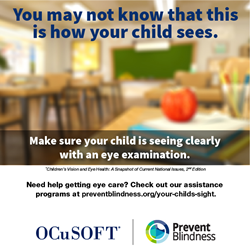
Healthy vision can help a child succeed in the classroom. Prevent Blindness declares August as Children’s Eye Health and Safety Month to promote healthy eyesight for kids.
“Making sure our children have healthy vision must be a priority today, to help them to see clearly for years to come,” said Jeff Todd, president and CEO of Prevent Blindness.
CHICAGO (PRWEB)
July 27, 2021
In August, many children are headed back to school. One of the best ways to help students succeed in the classroom is to make sure they are seeing clearly. Prevent Blindness, the nation’s oldest eye health and safety nonprofit organization, has declared August as Children’s Eye Health and Safety Month to provide the public with helpful information to put kids on the path to a lifetime of healthy vision.
According to the recent study, “Children’s Vision and Eye Health: A Snapshot of Current National Issues 2nd Edition,” vision has a critical role in children’s physical, cognitive, and social development, and visual functioning is a strong predictor of academic performance in school-age children. Without early detection and treatment, uncorrected vision disorders can impair child development, interfere with learning, and even lead to permanent vision loss.
Common vision problems in children include amblyopia (lazy eye), strabismus (crossed eyes), and refractive errors, such as myopia, hyperopia and astigmatism. Nearly three percent of children younger than 18 years are blind or visually impaired, defined as having trouble seeing even when wearing glasses or contact lenses.
A child who does the following may have possible eye and vision problems:
- Rubs eyes a lot
- Closes or covers one eye
- Tilts head or thrusts head forward
- Has trouble reading or doing other close-up work, or holds objects close to eyes to see
- Blinks more than usual or seems cranky when doing close-up work
- Says things are blurry or hard to see
- Squints eyes or frowns
Children with eye problems may also appear to have eyes that do not line up, (one eye appears crossed or looks out), eyelids that are red-rimmed, crusted or swollen, and/or eyes that are watery or red. However, a child may still have an eye problem even if he or she does not complain or has not shown any unusual signs.
Additionally, extended screen time among children has become a concern for many parents, caregivers and educators. Digital screens have become a common part of a child’s world, used for interactive play, reading, learning, and to socially connect. The daily time a child spends viewing a digital screen (including a cell phone, tablet, laptop, computer, TV, or gaming screen) can add up quickly.
Prevent Blindness, in coordination with Children’s Vision Massachusetts and School Health, has created a new web resource and free “Children’s Vision Digital Screen Tips” posters in English and Spanish, available for download at: https://preventblindness.org/childrens-screen-time-tips/.
The National Center for Children’s Vision and Eye Health at Prevent Blindness (NCCVEH) also provides a wide variety of free, informational resources about everything from baby’s developing sight, to school readiness, to recommended eye protection for sports and UV. Vision care financial assistance resources in English and Spanish may also be found at: http://preventblindness.org/vision-care-financial-assistance-information/.
“Making sure our children have healthy vision must be a priority today, to help them to see clearly for years to come,” said Jeff Todd, president and CEO of Prevent Blindness. “We provide a variety of helpful resources for children of all ages to help ensure our kids have a bright future with healthy eyesight.”
For more information on children’s eye health and safety, the NCCVEH, or financial assistance programs, please call Prevent Blindness at (800) 331-2020 or visit https://preventblindness.org/.
About Prevent Blindness
Founded in 1908, Prevent Blindness is the nation’s leading volunteer eye health and safety organization dedicated to fighting blindness and saving sight. Focused on promoting a continuum of vision care, Prevent Blindness touches the lives of millions of people each year through public and professional education, advocacy, certified vision screening and training, community and patient service programs and research. These services are made possible through the generous support of the American public. Together with a network of affiliates, Prevent Blindness is committed to eliminating preventable blindness in America. For more information, visit us at preventblindness.org, and follow us on Facebook, Twitter, Instagram and LinkedIn.
Share article on social media or email:

